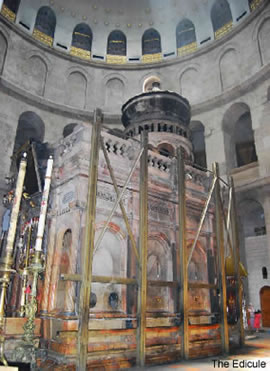
Armenian News Network / Groong
November 10, 2008
By Arthur Hagopian
JERUSALEM

|
| Inside The Holy Sepulchre |
The Church of the Holy Sepulchre, the traditional site of the tomb of Jesus of Nazareth, and regarded by many as the holiest relic in the whole of Christendom, has once again become the unwelcome theatre of an unsightly brawl between two brotherly Christian denominations.
Though not a stranger to such flagrant eruptions, the extent of the violence this time repelled every one who witnessed the drama as graphically captured videos streamed it on world TV.
Relations among the three guardians of the Holy Places in and around Jerusalem, the Latin Custodia and the Greek and Armenian Patriarchates, are governed by a "status quo" that relies in turn on edicts issued by the Ottoman sultans who ruled the land for over 5 centuries.
The guardians enjoy exclusive proprietary rights, guaranteed by Sultan Abdul Majid, under the "status quo" arrangement which encapsulates the final and most important pledge, his "firman", which he made over 150 years ago, and which "defines, regulates and maintains, without change" these rights, according to Jerusalem church sources.
This declaration officially established the principle of "Status Quo" (i.e. existing "as is" condition) in the Holy Places, which defines, regulates and maintains, without change, the proprietary rights in the Holy Places granted exclusively to the three major Christian, thus making the Armenian Church equal in stature to the Catholic and Greek Orthodox Churches despite its relatively small size, the sources said.
With these edicts, or "firman"s, spelling out in general terms, the rights and privileges to be enjoyed by each Christian denomination, any departure would inevitably result in confrontation, and if not controlled or resolved, the issue would spell out into a major confrontation.
The "status quo" covers every aspect of the ownership and maintenance of the Holy Places, including such seemingly innocuous activities as the number of floor tiles each denomination can lawfully sweep. Sweep one more outside your jurisdiction, and you have committed an unforgivable breach.
One side-effect of the status quo is the paralysis it imposes on some aspects of governance and maintenance: take, for instance, the case of the ladder placed on a ledge at the entrance to the church. It has been lying there untouched for decades because of the inability of the guardians to decide who had the right to access it.
The three guardians endeavor to keep relations among the various Christian churches harmonious, but it is a daunting task because of territorial jealousies, church sources say.
The issue this time was whether the Greek Patriarchate had the right to place one of its priests inside the Edicule, the vestibule outside the entryway to the tomb, during a procession conducted by the Armenian Orthodox church on the occasion of the marking of the discovery of the cross on which Jesus was crucified.
Citing an 1829 firman, which stipulated that "no interference or interventions should ever be allowed to occur in respect of the celebration of mass and other processions of the [Armenian] community," the Armenian Patriarchate charged the Greeks with gross violation of its old rights.
"Despite several written protests," the Patriarchate said in a statement, "numerous attempts to peacefully resolve this conflict at Status Quo Committee meetings, and despite the most recent negotiations" with the Christian Affairs Department of the [Israeli] Interior Ministry, as well as Jerusalem's Old City police commander, the Greeks again disrupted an Armenian solemn procession, by placing a monk within the edicule.
Outraged, Armenian priests tried to physically prevent the Greek from entering the edicule. But dozens of Greek monks who had gathered prior to the commencement of the procession, came to the aid of their compatriot, and "forcibly attempted to enter the edicule," the Armenian Patriarchate said.
Israeli police had to intervene, forming a barrier between the two warring sides, but could not prevent the Greeks from attacking the Armenian priests and seminarians, resulting in bloody scuffles, according to the Patriarchate.
One Armenian monk was briefly retained before being released.
"The presence of a Greek monk inside the edicule is a serious violation of the status quo governing the Holy Places, over which the Armenians, Latins and Greek Orthodox share equal rights of custodianship, "the Armenian Patriarchate said.
"The Armenian Patriarchate has made its position clear that on the feast of the holy cross," which falls on the fist Sunday of Great Lent, Palm Sunday and Holy Fire Saturday (marking the resurrection of Jesus), when they are in procession of the Holy Tomb, the Greeks should refrain from placing their monk inside the edicule," it added.
This was something the Greeks were evidently unwilling to concede.
And not until such time as the message of peace, mercy and love that Jesus of Nazareth preached two thousand years ago, does finally overwhelm the heart and mind of those who follow him in Jerusalem, and they acknowledge their common bond in Christ's lovingkindness, will conflict be banned from Christendom's holiest shrine.
-- Arthur Hagopian is a Jerusalem Armenian and has worked at the Patriarchate as Press Officer and personal secretary for His Beatitude Patriarch Manoogian. He has worked for major news organizations like Reuters and AP, and holds a MA in educational administration, authoring, web development.
|
Redistribution of Groong articles, such as this one, to any other
media, including but not limited to other mailing lists and Usenet
bulletin boards, is strictly prohibited without prior written
consent from Groong's Administrator. © Copyright 2008 Armenian News Network/Groong. All Rights Reserved. |
|---|